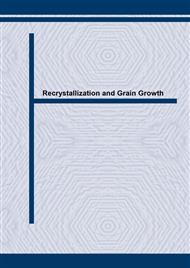p.45
p.51
p.57
p.63
p.69
p.75
p.81
p.87
p.93
Orientation Spread in Deformed Grains and Its Relevance to Recrystallization Texture Development in IF Steels
Abstract:
Deformation characteristics of cold rolled grains and their contribution to the development of recrystallization texture in IF steel were investigated using EBSD. Quantitative evaluation of the intra-granular orientation spread in the deformed grains was attempted. Both of the GAM and SGS could represent the orientation spread but in different manner. The GAM value was higher in {111}//ND orientations than in other orientation groups implying steep orientation gradient within short ranges in {111}//ND oriented grains. This steep orientation gradient was generally originated from the existence of deformation heterogeneities. Particularly, {111}<112> orientation which was the dominant component in the recrystallization texture showed the maximum values of both GAM and SGS, which was caused by the frequent development of shear bands. SGS values of {001}//ND oriented soft grains were unexpectedly large in spite of their small GAM values. It could be confirmed that their uniform deformation behavior led to the gentle but monotonous orientation gradient in long ranges. The lowest values of both GAM and SGS were obtained in the {112}<110> orientation, probably, because of the highest orientation stability in that orientation during plain strain deformation condition. GAM was more closely related to the development of recrystallization texture and the significance of the steep orientation gradient in the recrystallization behavior should be re-addressed.
Info:
Periodical:
Pages:
69-74
Citation:
Online since:
October 2004
Authors:
Price:
Сopyright:
© 2004 Trans Tech Publications Ltd. All Rights Reserved
Share:
Citation:


